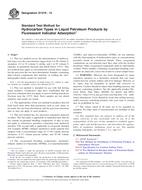Potrebujeme váš súhlas na využitie jednotlivých dát, aby sa vám okrem iného mohli ukazovať informácie týkajúce sa vašich záujmov. Súhlas udelíte kliknutím na tlačidlo „OK“.
ASTM D1319-13
Standard Test Method for Hydrocarbon Types in Liquid Petroleum Products by Fluorescent Indicator Adsorption
Automaticky preložený názov:
Štandardná skúšobná metóda pre uhľovodíkových typov v kvapalnom ropných produktov fluorescenčným indikátorom Adsorpcia
NORMA vydaná dňa 1.5.2013
Informácie o norme:
Označenie normy: ASTM D1319-13
Poznámka: NEPLATNÁ
Dátum vydania normy: 1.5.2013
Kód tovaru: NS-16971
Počet strán: 7
Približná hmotnosť: 21 g (0.05 libier)
Krajina: Americká technická norma
Kategória: Technické normy ASTM
Anotácia textu normy ASTM D1319-13 :
Keywords:
aromatics, fluorescent indicator adsorption (FIA), hydrocarbon types, olefins, saturates, ICS Number Code 75.080 (Petroleum products in general)
Doplňujúce informácie
| Significance and Use | ||||||||||||||||||||
|
5.1 The determination of the total volume % of saturates, olefins, and aromatics in petroleum fractions is important in characterizing the quality of petroleum fractions as gasoline blending components and as feeds to catalytic reforming processes. This information is also important in characterizing petroleum fractions and products from catalytic reforming and from thermal and catalytic cracking as blending components for motor and aviation fuels. This information is also important as a measure of the quality of fuels, such as specified in Specification D1655. |
||||||||||||||||||||
| 1. Scope | ||||||||||||||||||||
|
1.1 This test method covers the determination of hydrocarbon types over the concentration ranges from 5 to 99 volume % aromatics, 0.3 to 55 volume % olefins, and 1 to 95 volume % saturates in petroleum fractions that distill below 315°C. This test method may apply to concentrations outside these ranges, but the precision has not been determined. Samples containing dark-colored components that interfere in reading the chromatographic bands cannot be analyzed. 1.2 This test method is intended for
use with full boiling range products. Cooperative data have
established that the precision statement does not apply to narrow
boiling petroleum fractions near the 315°C limit. Such samples are
not eluted properly, and results are erratic.
1.3 The applicability of this test method to products derived from fossil fuels other than petroleum, such as coal, shale, or tar sands, has not been determined, and the precision statement may or may not apply to such products. 1.4 This test method has two precision statements depicted in tables. The first table is applicable to unleaded fuels that do not contain oxygenated blending components. It may or may not apply to automotive gasolines containing lead antiknock mixtures. The second table is applicable to oxygenate blended (for example, MTBE, ethanol) automotive spark ignition fuel samples with a concentration range of 13–40 volume percent aromatics, 4–33 volume percent olefins, and 45–68 volume percent saturates. 1.5 The oxygenated blending components, methanol, ethanol, methyl-tert-butylether (MTBE), tert-amylmethylether (TAME), and ethyl-tert-butylether (ETBE), do not interfere with the determination of hydrocarbon types at concentrations normally found in commercial blends. These oxygenated components are not detected since they elute with the alcohol desorbent. Other oxygenated compounds shall be individually verified. When samples containing oxygenated blending components are analyzed, correct the results to a total-sample basis. 1.6 WARNING—Mercury has been designated by many regulatory agencies as a hazardous material that can cause central nervous system, kidney and liver damage. Mercury, or its vapor, may be hazardous to health and corrosive to materials. Caution should be taken when handling mercury and mercury containing products. See the applicable product Material Safety Data Sheet (MSDS) for details and EPA’s website—http://www.epa.gov/mercury/faq.htm—for additional information. Users should be aware that selling mercury and/or mercury containing products into your state or country may be prohibited by law. 1.7 The values stated in SI units are to be regarded as standard. No other units of measurement are included in this standard. 1.8 This standard does not
purport to address all of the safety concerns, if any, associated
with its use. It is the responsibility of the user of this standard
to establish appropriate safety and health practices and determine
the applicability of regulatory limitations prior to use.
Standard Specification for Woven Wire
Test Sieve Cloth and Test Sieves Standard Practice for Statistical
Assessment and Improvement of Expected Agreement Between Two Test
Methods that Purport to Measure the Same Property of a Material Standard Test Method for Determination of
Benzene, Toluene, and Total Aromatics in Finished Gasolines by Gas
Chromatography/Mass Spectrometry Standard Test Method for Determination of
Oxygenates in Gasoline by Gas Chromatography and Oxygen Selective
Flame Ionization Detection Standard Test Method for Bromine Index of
Petroleum Hydrocarbons by Electrometric Titration Standard Practice for Manual Sampling of
Petroleum and Petroleum Products Standard Test Method for Surface Area of
Catalysts and Catalyst Carriers Standard Test Method for Distillation of
Petroleum Products and Liquid Fuels at Atmospheric Pressure
(Includes all amendments and changes 2/9/2024). Standard Specification for Aviation
Turbine Fuels (Includes all amendments and changes 10/11/2023). Standard Test Method for Determination of
MTBE, ETBE, TAME, DIPE, tertiary-Amyl Alcohol and C1 to C4 Alcohols
in Gasoline by Gas Chromatography |
Odporúčame:
EviZak - všetky zákony vrátane ich evidencie na jednom mieste
Poskytovanie aktuálnych informácií o legislatívnych predpisoch vyhlásených v Zbierke zákonov od roku 1945.
Aktualizácia 2x v mesiaci !
Chcete vedieť viac informácii ? Pozrite sa na túto stránku.




 Cookies
Cookies
